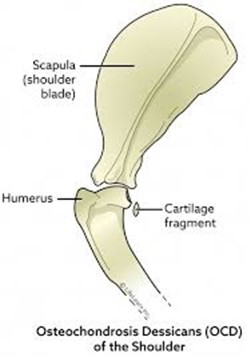Osteochondrosis dissecans (OCD)
Overview:
Osteochondrosis is a developmental disorder of rapidly growing, large and giant breed dogs. It is characterized by abnormal endochondral ossification of cartilage in the shoulder, elbow, stifle, or hock joints. Endochondral ossification is the normal bone-growth process by which cartilage is replaced by bone in the early development of the fetus.
Osteochondrosis begins with a failure of the immature cartilage to form into bone in, most commonly, the humeral head (shoulder). This leads to abnormal cartilage, which is thicker and weaker, which in turn leads to cartilage cracks, fissures and flap formation after minor trauma or normal pressure to the joint. These flaps (called dissecans) may remain attached or become loose and fall into the joint space. These unattached, fallen flaps can increase in size with calcification and are called “joint mice”.
The onset of the disease may begin as early as 4 months of age and as late as 14 months of age. The most typical age of appearance, however, is between 6 and 8 months and occurs more often in male dogs. The causes of OCD are multifactorial with genetic and nutritional interactions thought to be the central factors. Risk factors may include breed genetics, age, rapid growth, nutrient excesses (primarily protein, calcium, and phosphorus), trauma and gender.

Warning Signs and Symptoms:
Clinical signs include lameness or limping in affected leg. In some cases, the lameness may be mild and intermittent, while in others, the dog may be in constant pain and avoids bearing weight on the affected leg. In many cases, a gradual onset of lameness improves after rest and worsens after exercise. The joint may be swollen and warm to the touch and, when manipulated, may be painful to the dog. With chronic lameness, there can be wasting of the muscles.
What to do:
Keep your dog’s activity limited. Seek veterinary advice and contact your breeder.
What to expect at the vet:
Your veterinarian will conduct a thorough medical history of your dog’s health, onset of symptoms and any information you have about your dog’s parentage. He will examine the dog’s affected joints carefully.
Radiography imaging is the best tool for diagnosis of this problem and several x-rays of the affected joints will be taken to get an accurate assessment of various bones and joints. The vet may also x-ray the unaffected joint to see if any disease exists there. Some cases will also require samples of synovial fluid from the joint and some may require arthroscopy for diagnosis. Your veterinarian may also want a CBC and urinalysis to assess overall health of the dog.
Treatment/Prevention:
Mild cases of osteochondrosis (without dissecans) may be treated conservatively and heal spontaneously with several weeks of rest and treatment with anti-inflammatory drugs such as NSAIDs or the drug, Adequan. Supplements such as glucosamine, chondroitin, MSM and Vitamin C may also help joint recovery. Most cases of OCD will require corrective surgery or arthroscopic surgery to remove flaps of cartilage and any loose fragments within the joint. Surgical repair of OCD of the shoulder usually renders excellent results. Surgical results involving other joints are not as predictable.
After surgery, your dog will be restricted to short leash walks for 4 to 6 weeks and you may be instructed to perform range of motion exercises. You will need to keep weight control measures in place to reduce stress on the joints. Anti-inflammatory medications and joint supplements will most likely be prescribed to help your dog recover and be more comfortable.
Resources:
Osteochondrosis in Small Animals by Harari, Joseph, MS, DVM, DACVS. Veterinary Surgical specialists, Spokane, WA (Merck Manual)
Osteochondrosis of the Shoulder. American College of Veterinary Surgeons.
Osteochondritis Dissecans (OCD) in Dogs by Hunter, Tammy, DVM; Yuill, Cheryl, DVM, MSc, CvH.
Osteochondritis Dissecans (OCD) in Dogs by Heuer, Victoria. PetMD
GSMDCA Health Concerns article on Osteochondrosis Dissecans
